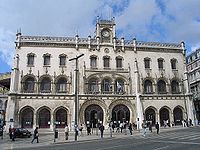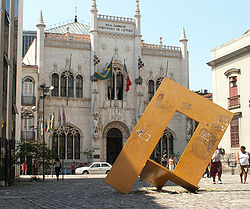
Neo-Manueline
Encyclopedia


Portugal
Portugal , officially the Portuguese Republic is a country situated in southwestern Europe on the Iberian Peninsula. Portugal is the westernmost country of Europe, and is bordered by the Atlantic Ocean to the West and South and by Spain to the North and East. The Atlantic archipelagos of the...
between the middle of the 19th century and the beginning of the 20th century. The style adopted the characteristics of the Manueline
Manueline
The Manueline, or Portuguese late Gothic, is the sumptuous, composite Portuguese style of architectural ornamentation of the first decades of the 16th century, incorporating maritime elements and representations of the discoveries brought from the voyages of Vasco da Gama and Pedro Álvares Cabral...
(or Portuguese Final Gothic) of the 16th century.
History
The term manuelino was introduced in 1842 by Brazilian art historian Francisco Adolfo de VarnhagenFrancisco Adolfo de Varnhagen
Francisco Adolfo de Varnhagen, Viscount of Porto Seguro was a Brazilian military, diplomat and historian. He is the patron of the 39th chair of the Brazilian Academy of Letters.-Life:...
to designate the exuberant artistic style that developed during the reign of Manuel I of Portugal
Manuel I of Portugal
Manuel I , the Fortunate , 14th king of Portugal and the Algarves was the son of Infante Ferdinand, Duke of Viseu, , by his wife, Infanta Beatrice of Portugal...
(1495–1521). The Manueline style coincided with the Age of Discovery
Age of Discovery
The Age of Discovery, also known as the Age of Exploration and the Great Navigations , was a period in history starting in the early 15th century and continuing into the early 17th century during which Europeans engaged in intensive exploration of the world, establishing direct contacts with...
and the peak of Portuguese maritime power. In the sequence of the Gothic Revival architecture
Gothic Revival architecture
The Gothic Revival is an architectural movement that began in the 1740s in England...
fashion that spread for all over Europe
Europe
Europe is, by convention, one of the world's seven continents. Comprising the westernmost peninsula of Eurasia, Europe is generally 'divided' from Asia to its east by the watershed divides of the Ural and Caucasus Mountains, the Ural River, the Caspian and Black Seas, and the waterways connecting...
since the middle of the 18th century, the Manueline style was considered the most authentical Portuguese architectural style.
Neo-Manueline started with the construction of the Pena Palace in Sintra
Sintra
Sintra is a town within the municipality of Sintra in the Grande Lisboa subregion of Portugal. Owing to its 19th century Romantic architecture and landscapes, becoming a major tourist centre, visited by many day-trippers who travel from the urbanized suburbs and capital of Lisbon.In addition to...
by Ferdinand II
Ferdinand II of Portugal
Ferdinand of Saxe-Coburg and Gotha , named Prince Ferdinand Augustus Francis Anthony of Saxe-Coburg-Gotha-Koháry, was King of Portugal as husband of Queen Maria II of Portugal from the birth of their son in 1837 to her death in 1853.In keeping with Portuguese law, only after the birth of his son in...
between 1839 and 1849. Another pioneering project was the restoration of the Jerónimos Monastery
Jerónimos Monastery
The Hieronymites Monastery is located near the shore of the parish of Belém, in the municipality of Lisbon, Portugal...
in Lisbon
Lisbon
Lisbon is the capital city and largest city of Portugal with a population of 545,245 within its administrative limits on a land area of . The urban area of Lisbon extends beyond the administrative city limits with a population of 3 million on an area of , making it the 9th most populous urban...
during the 1860s, in which the Manueline monastery gained a new tower and annexes built in Neo-Manueline style (which now house the Maritime Museum
Maritime Museum (Lisbon)
The Navy Museum of Lisbon is dedicated to all aspects of the History of navigation in Portugal. The museum is administered by the Portuguese Navy and is located in the touristic district of Belém...
and the National Archaeology Museum). During this time the iconic Belém Tower
Belém Tower
Belém Tower or the Tower of St Vincent is a fortified tower located in the civil parish of Santa Maria de Belém in the municipality of Lisbon, Portugal...
was also restored with several Neo-Manueline additions.
Neo-Manueline eventually spread to the colonies and former Portuguese colonies. In Brazil
Brazil
Brazil , officially the Federative Republic of Brazil , is the largest country in South America. It is the world's fifth largest country, both by geographical area and by population with over 192 million people...
there are several Neo-Manueline buildings, usually built by Portuguese associations. The most important of these is the Real Gabinete Português de Leitura (Royal Portuguese Library), built between 1880 and 1887 by Portuguese immigrants in the centre of Rio de Janeiro
Rio de Janeiro
Rio de Janeiro , commonly referred to simply as Rio, is the capital city of the State of Rio de Janeiro, the second largest city of Brazil, and the third largest metropolitan area and agglomeration in South America, boasting approximately 6.3 million people within the city proper, making it the 6th...
.
Other important Neo-Manueline buildings, in Portugal, are Rossio Railway Station
Rossio Train Station
The Rossio Railway Station is a train station in Lisbon, Portugal, located in the Rossio square. The station was formerly known as Estação Central and that designation still appears in its façade....
, Lisbon
Lisbon
Lisbon is the capital city and largest city of Portugal with a population of 545,245 within its administrative limits on a land area of . The urban area of Lisbon extends beyond the administrative city limits with a population of 3 million on an area of , making it the 9th most populous urban...
(1886–1890), Palace Hotel of Bussaco
Palace Hotel of Bussaco
The Palace Hotel of Bussaco , is a luxury hotel located in the mountain range of Serra do Bussaco, in the municipality of Mealhada, in central Portugal.-History:...
(1888–1907), the Sintra Town Hall (1906–1909), the Counts of Castro Guimarães Palace in Cascais
Cascais
Cascais is a coastal town in Cascais Municipality in Portugal, 30 kilometres west of Lisbon, with about 35,000 residents. It is a cosmopolitan suburb of the Portuguese capital and one of the richest municipalities in Portugal. The former fishing village gained fame as a resort for Portugal's royal...
(1900) and the Quinta da Regaleira
Quinta da Regaleira
Quinta da Regaleira is an estate located near the historic center of Sintra, Portugal. It is classified as a World Heritage Site by UNESCO within the "Cultural Landscape of Sintra". Along with other palaces in this area , it is one of the principal tourist attractions of Sintra...
in Sintra
Sintra
Sintra is a town within the municipality of Sintra in the Grande Lisboa subregion of Portugal. Owing to its 19th century Romantic architecture and landscapes, becoming a major tourist centre, visited by many day-trippers who travel from the urbanized suburbs and capital of Lisbon.In addition to...
(1904–1910). The Neo-Manueline was also used in smaller buildings like private houses.
In Brazil
Brazil
Brazil , officially the Federative Republic of Brazil , is the largest country in South America. It is the world's fifth largest country, both by geographical area and by population with over 192 million people...
, apart from the Real Gabinete Português de Leitura (Royal Portuguese Library), Rio de Janeiro
Rio de Janeiro
Rio de Janeiro , commonly referred to simply as Rio, is the capital city of the State of Rio de Janeiro, the second largest city of Brazil, and the third largest metropolitan area and agglomeration in South America, boasting approximately 6.3 million people within the city proper, making it the 6th...
(1880–1887), Neo-Manueline buildings include the Portuguese Center in Santos
Santos (São Paulo)
-Sister cities: Shimonoseki, Japan Nagasaki, Japan Funchal, Portugal Trieste, Italy Coimbra, Portugal Ansião, Portugal Arouca, Portugal Ushuaia, Argentina Havana, Cuba Taizhou. China Ningbo. China Constanţa, Romania Ulsan, South Korea Colón, Panama* Cadiz, Spain...
(Centro Português de Santos, 1898–1901), the Portuguese Library of Bahia
Bahia
Bahia is one of the 26 states of Brazil, and is located in the northeastern part of the country on the Atlantic coast. It is the fourth most populous Brazilian state after São Paulo, Minas Gerais and Rio de Janeiro, and the fifth-largest in size...
(1915–1918) and the Portuguese Literary Liceum (Liceu Literário Português) in Rio de Janeiro (1938).
Other examples of Neo-Manueline buildings can also be found in Africa
Africa
Africa is the world's second largest and second most populous continent, after Asia. At about 30.2 million km² including adjacent islands, it covers 6% of the Earth's total surface area and 20.4% of the total land area...
n and Asia
Asia
Asia is the world's largest and most populous continent, located primarily in the eastern and northern hemispheres. It covers 8.7% of the Earth's total surface area and with approximately 3.879 billion people, it hosts 60% of the world's current human population...
n territories of the former Portuguese Colonial Empire
Portuguese Empire
The Portuguese Empire , also known as the Portuguese Overseas Empire or the Portuguese Colonial Empire , was the first global empire in history...
.
There are also some examples of Neo-Manueline style in countries that were not directly related with the Portuguese culture. A fine example is Morozov Palace (1894–1898) in Moscow
Moscow
Moscow is the capital, the most populous city, and the most populous federal subject of Russia. The city is a major political, economic, cultural, scientific, religious, financial, educational, and transportation centre of Russia and the continent...
, Russia
Russia
Russia or , officially known as both Russia and the Russian Federation , is a country in northern Eurasia. It is a federal semi-presidential republic, comprising 83 federal subjects...
.

